
Santa Clara Pueblo "Singing Water Village", also known as "Village of Wild Roses" is a census-designated place (CDP) in Rio Arriba County, New Mexico, United States and a federally recognized tribe of Native American Pueblo people.
The Pueblo Revolt of 1680, also known as Popé's Rebellion or Po'pay's Rebellion, was an uprising of most of the indigenous Pueblo people against the Spanish colonizers in the province of Santa Fe de Nuevo México, larger than present-day New Mexico. Incidents of brutality and cruelty, coupled with persistent Spanish policies that stoked animosity, gave rise to the eventual Revolt of 1680. The persecution and mistreatment of Pueblo people who adhered to traditional religious practices was the most despised of these. The Spaniards were resolved to abolish "pagan" forms of worship and replace them with Christianity. The Pueblo Revolt killed 400 Spaniards and drove the remaining 2,000 settlers out of the province. The Spaniards returned to New Mexico twelve years later.
Native American studies is an interdisciplinary academic field that examines the history, culture, politics, issues, spirituality, sociology and contemporary experience of Native peoples in North America, or, taking a hemispheric approach, the Americas. Increasingly, debate has focused on the differences rather than the similarities between other ethnic studies disciplines such as African American studies, Asian American studies, and Latino/a studies.

The Institute of American Indian Arts (IAIA) is a public tribal land-grant college in Santa Fe, New Mexico, United States. The college focuses on Native American art. It operates the Museum of Contemporary Native Arts (MoCNA), which is housed in the historic Santa Fe Federal Building, a landmark Pueblo Revival building listed on the National Register of Historic Places as Federal Building. The museum houses the National Collection of Contemporary Indian Art, with more than 7,000 items.
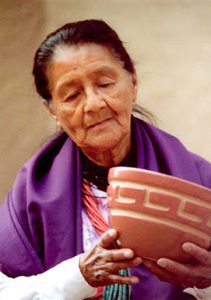
Maria Margarita "Margaret" Tafoya was the matriarch of Santa Clara Pueblo potters. She was a recipient of a 1984 National Heritage Fellowship awarded by the National Endowment for the Arts, which is the United States government's highest honor in the folk and traditional arts.

Roxanne Swentzell is a Santa Clara Tewa Native American sculptor, ceramic artist, Indigenous food activist, and gallerist. Her artworks are in major public collections and she has won numerous awards.

The School for Advanced Research (SAR), until 2007 known as the School of American Research and founded in 1907 as the School for American Archaeology (SAA), is an advanced research center located in Santa Fe, New Mexico, U.S. Since 1967, the scope of the school's activities has embraced a global perspective through programs to encourage advanced scholarship in anthropology and related social science disciplines and the humanities, and to facilitate the work of Native American scholars and artists. SAR offers residential fellowships for artists and scholars, and it publishes academic and popular non-fiction books through SAR Press.
Ethnoscience has been defined as an attempt "to reconstitute what serves as science for others, their practices of looking after themselves and their bodies, their botanical knowledge, but also their forms of classification, of making connections, etc.".
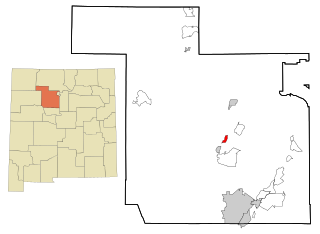
Jemez Pueblo is a census-designated place (CDP) in Sandoval County, New Mexico, United States. The population was 1,788 at the 2010 census. It is part of the Albuquerque Metropolitan Statistical Area.
Angayuqaq Oscar Kawagley, best known as Oscar Kawagley, was a Yup'ik anthropologist, teacher and actor from Alaska. He was an associate professor of education at the University of Alaska, Fairbanks until his death in 2011. The Anchorage Daily News described him as "one of (Alaska's) most influential teachers and thinkers".

Gerónima Cruz Montoya (Potsunu) was an Ohkay Owingeh Pueblo artist and educator from New Mexico. She taught Native American artists at the Studio at the Santa Fe Indian School.
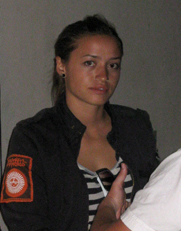
Rose B. Simpson of Khaʼpʼoe Ówîngeh is a mixed-media artist who works in ceramic, metal, fashion, painting, music, performance, and installation. She lives and works in Santa Clara Pueblo, New Mexico. Her work has been exhibited at SITE Santa Fe ; the Heard Museum ; the Museum of Contemporary Native Art, Santa Fe (2010); the National Museum of the American Indian, Smithsonian (2008); the Denver Art Museum; Pomona College Museum of Art (2016); Ford Foundation Gallery (2019); The Wheelwright Museum of the American Indian (2017); the Minneapolis Institute of Art (2019); the Savannah College of Art and Design (2020); the Nevada Museum of Art (2021); Whitney Museum of American Art, and the Norton Museum of Art (2024).
Mark S. Cladis is an author and the Brooke Russell Astor Professor of the Humanities at Brown University. Since arriving at Brown in 2004, he served as Chair for several 3-year terms. His teaching and scholarship are located at the various intersections of religious studies, philosophy, and environmental humanities. He has published five books. His current book project is Radical Romanticism, Democracy, and the Environmental Imagination. He has also published over sixty articles, essays, and chapters in edited books.
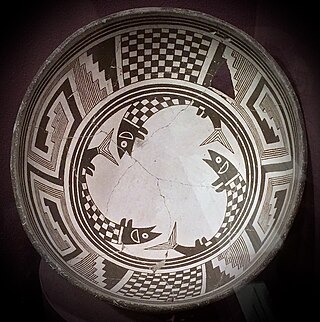
Pueblo pottery are ceramic objects made by the Indigenous Pueblo people and their antecedents, the Ancestral Puebloans and Mogollon cultures in the Southwestern United States and Northern Mexico. For centuries, pottery has been central to pueblo life as a feature of ceremonial and utilitarian usage. The clay is locally sourced, most frequently handmade, and fired traditionally in an earthen pit. These items take the form of storage jars, canteens, serving bowls, seed jars, and ladles. Some utility wares were undecorated except from simple corrugations or marks made with a stick or fingernail, however many examples for centuries were painted with abstract or representational motifs. Some pueblos made effigy vessels, fetishes or figurines. During modern times, pueblo pottery was produced specifically as an art form to serve an economic function. This role is not dissimilar to prehistoric times when pottery was traded throughout the Southwest, and in historic times after contact with the Spanish colonialists.

José Vicente Aguilar, also called Sua Peen, is a Pueblo-American painter of San Ildefonso Pueblo and Picurís Pueblo heritage. He is known for his watercolor paintings. Aguilar has exhibited across the United States, particularly in the Southwest, and his work is in the permanent collection of institutions including the Gilcrease Museum.
Indigenous science is the application and intersection of Indigenous knowledge and science. In ecology, this is sometimes termed traditional ecological knowledge. Indigenous science refers to the knowledge systems and practices of Indigenous peoples, which are rooted in their cultural traditions and relationships to their indigenous context. It follows the same methods of Western science including : observation, prediction, interpretation, questioning. The knowledge and information that Indigenous people have was often devalued by white European and American scientists and explorers. However, there has been a growing recognition of the benefits of incorporating Indigenous perspectives and knowledge particularly in fields such as ecology and environmental management.
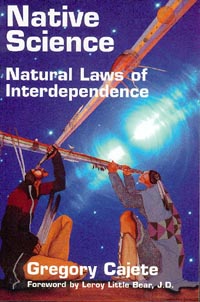
Native Science: Natural Laws of Interdependence is a 2001 book about traditional ecological knowledge by Gregory Cajete.










